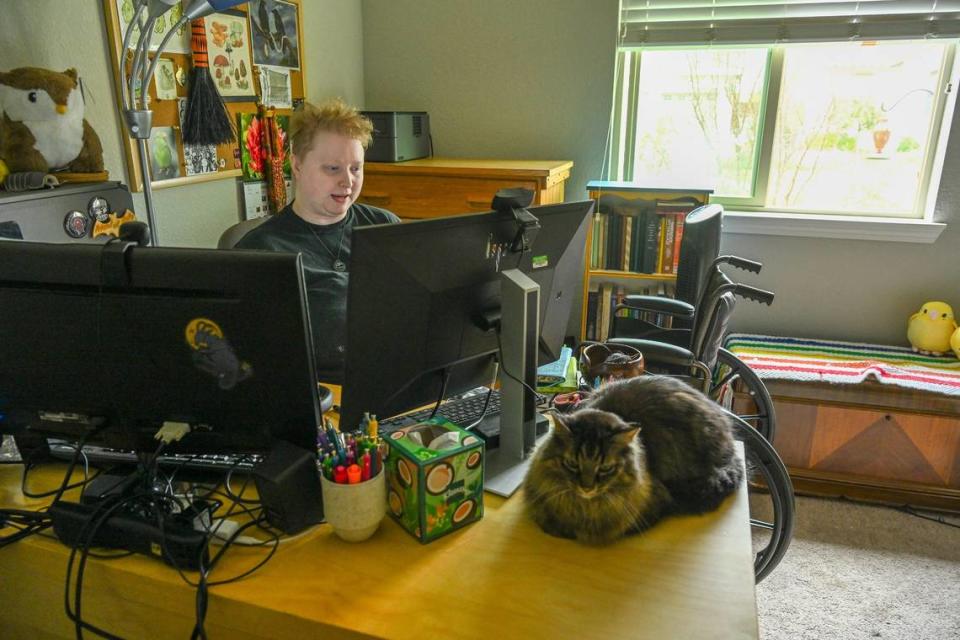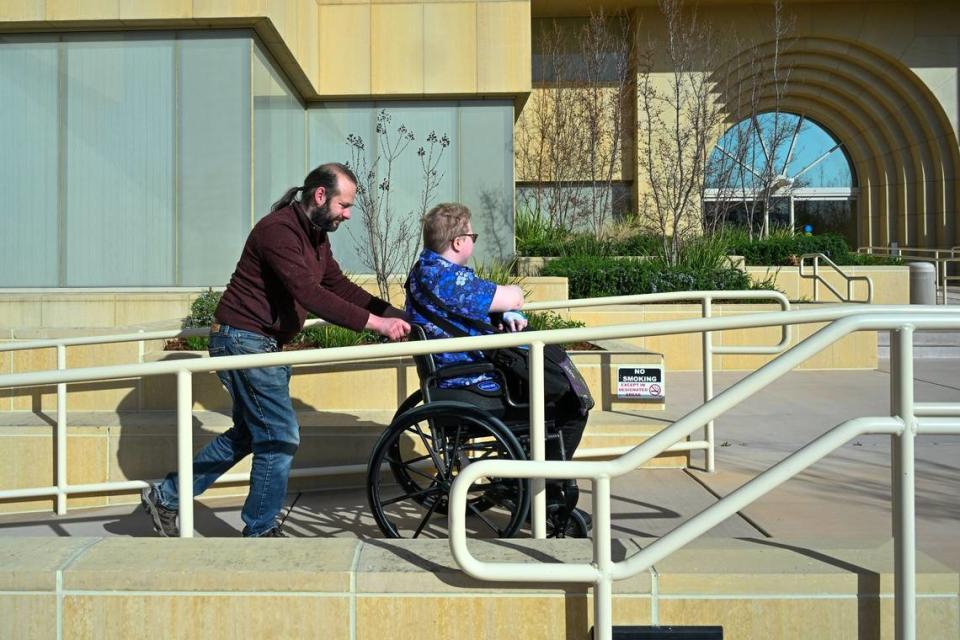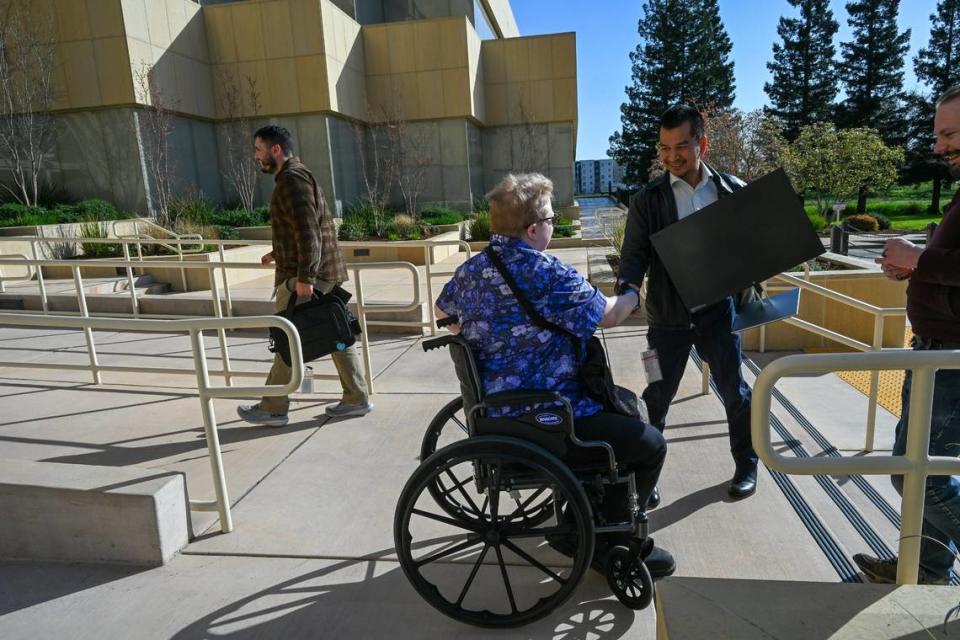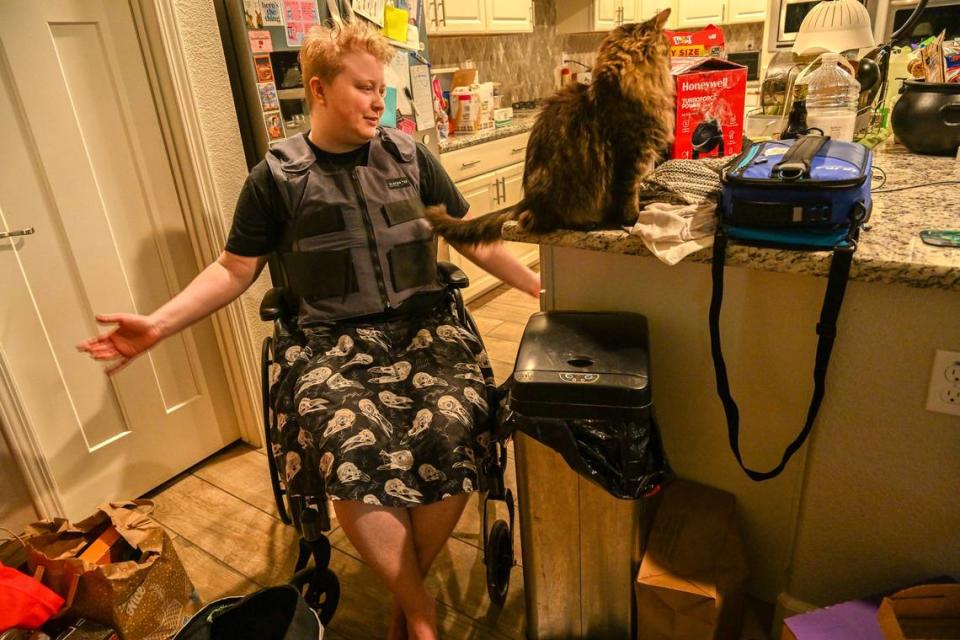A state worker’s doctor prescribed telework. But California forced him to return to office
Reality Check is a Sacramento Bee series holding those in power to account and shining a light on their decisions. Have a tip? Email realitycheck@sacbee.com.
Evan Underwood didn’t want to quit his information technology job with the California Department of General Services. But to protect his own health and safety, he felt he had no other choice.
The 32-year-old former state worker lives with an autoimmune disorder that prevents his body from properly regulating its internal temperature.
POTS, short for postural orthostatic tachycardia syndrome, is a genetic condition that causes Underwood to overheat whenever he’s in an environment warmer than about 70 degrees. His heart starts racing — often reaching 160 to 170 beats per minute. He starts feeling dizzy. Sometimes, he’ll even pass out. When in public, Underwood relies on a wheelchair, and he no longer drives himself. He barely leaves his house except for emergencies.
That’s why Underwood was shocked when he learned there would be no exceptions to his state agency’s two-day return-to-office policy. Not even for someone like him — a person with a disability and a doctor’s note to prove it.
“A warm office is actually a big medical problem for me,” Underwood said. “I literally get a fever.”
State employees have been largely opposed to the return-to-office edicts coming down from agency and departmental leadership in recent weeks. Many workers complain that commuting to the office would cost them precious time with their families and pets, not to mention extra money for fuel, parking, extra family vehicles and child care. Adding millions of state worker commute miles each week will also worsen road congestion and air pollution, employees argue.
But for some state workers who live with disabilities, returning to the office is a health and safety concern. Reasonable accommodations for people with disabilities also are a right guaranteed by the California Fair Employment and Housing Act.
“There is a really big problem with HR departments, including at the state and elsewhere, assuming that all work-from-home requests are a preference,” said Paula Tobler, a supervising attorney with the nonprofit advocacy group Disability Rights California. “That’s not the case when you’re talking about a disability accommodation.
“It’s not a preference. It’s a need.”
Tobler said public employers, including the state of California, have been “the worst” as far as refusing to negotiate or discuss the possibility of making a telework exception for people with disabilities.
Gov. Gavin Newsom’s office and departmental leadership cite collaboration, office morale and mentorship opportunities as anecdotal justifications for reinstating in-person work.
The Newsom administration also has repeatedly denied issuing an overarching return-to-office mandate — administration officials have previously said they chose not to issue a mandate so that departments and agencies could best assess and meet the needs of their employees.
The lack of clear top-down instruction — state workers have previously told The Sacramento Bee — led to inconsistencies and confusion between some agencies and departments.

For Underwood, and other state employees in need of reasonable accommodations, departments have so far provided little guidance and reassurance that employees would have their needs met in a timely way.
Underwood said he feels as though the state was telling people like him that attending in-person meetings was more important than staying healthy.
“I can’t come in twice a week. It just doesn’t give my body enough time to recover before I have to come in again and get sick,” said Underwood.
“I loved the job. I really had a wonderful time with the team. I loved the idea of working for the state and being in public service,” he added. “But physically, I just can’t do it.”
Reasonable accommodation request languished at DGS
Last fall, Underwood learned he would soon be laid off from his private-sector IT job. As he hunted for new positions, the option to telework was a key selling point given his health conditions. After all, he had worked remotely long before COVID-19 sent the rest of the world to their home offices.
In early October, Underwood landed an IT position with DGS. The job was advertised as eligible for five-day telework, he said. During the interview process, he was told he’d need to work in the office only once a month — a manageable feat.
But just a week after securing the offer, Underwood and the rest of his DGS colleagues learned that all employees would be expected to return to the office at least two days per week. Underwood had already given his two-week notice at his old job. At that point, his only choice was to move forward and hope he could receive accommodations to continue working from home.
At first, Underwood said he was hopeful. He filed his reasonable accommodation request with his supervisor on Oct. 18, nine days after DGS made the return-to-office announcement and as soon as he could get documentation from his doctor.
He didn’t hear back from the human resources office until December, and only then because he and his supervisors sent several follow-up emails.
“This is still under review as I have several requests I am trying to work through,” wrote Krisanne Booher, a DGS human resources manager, in a Dec. 11 email update to Underwood’s supervisor. “Keep in mind that our role is to come up with accommodations to remove workplace barriers that prevent an employee from working in the office environment, and not necessarily to provide telework.”
The reasonable accommodation officer in the HR department said she was “working through all requests in order of receipt.”
As the process dragged out, Underwood started having regrets about coming to work for the state.
“If I had known RTO was planned, I wouldn’t have applied for my current position,” Underwood wrote in a Dec. 18 email to his union, SEIU Local 1000. “And by the time it was announced, I had begun paperwork to depart my previous job, so I was stuck.”

Finally, a few days before the in-office mandate began on Jan. 2, Underwood received an unsatisfactory update.
“We have been letting employees know that while their RA request is in process, they should make arrangements to report to the office since we are not able to authorize temporary telework,” wrote Booher on Dec. 28. “The other option for employees who absolutely cannot report due to their disability, they may follow call-in procedures and use their leave credits.”
Underwood immediately wrote back saying these were not viable options. But when no response came, he knew he’d have to prepare for the worst.
The night before his first day of return-to-office, Underwood spent an hour preparing a care kit with three sets of strap-on ice packs, a portable fan and a thermometer to check the temperature in the office. In the morning, he enlisted his partner to pack up his wheelchair in the car and drive him to work – 40 miles round-trip from their home in Woodland to DGS headquarters in West Sacramento’s Ziggurat building.
By noon, Underwood was feeling dizzy, according to his symptom log. By 3 p.m., he was unable to work.
“Had to lay down briefly on the floor until the room stopped spinning,” Underwood wrote in his daily symptom log. “Slept 3.5 hours after work.”
For the next seven weeks, Underwood went through the same routine two days a week. Each in-office day, he said he felt weaker than the previous one. Some days his supervisor sent him home hours early because “apparently I looked like a wrung-out towel,” he wrote in his symptom log. His productivity dropped significantly compared to when he worked from home full time.
Even DGS senior leadership seemed to promote uniform enforcement of return-to-office rather than make case-by-case exceptions for people like Underwood.
“Until their RA is approved, they must come into the office two days per week and complete the telework agreement by tomorrow indicating at least two days per week in the office,” wrote DGS Chief Information Officer Gary Renslo in a Jan. 11 email to Underwood’s supervisor. “If their RA is approved and changes their telework schedule, they may submit a new agreement reflecting the changes.”
Finally, by Feb. 23, Underwood could no longer jump through the hoops. He submitted his resignation letter not knowing what would come next. He didn’t have another offer yet and wasn’t sure what he’d do for health care coverage. All he knew was that his body needed to stay at home. And if he couldn’t do his work from there, then his only option was to quit.
“I’ve been doing everything I can to stay cool, but it’s just not enough,” Underwood said.

In response to a detailed request for comment, DGS spokesperson Monica Hassan said the department could not speak to individual personnel matters. She said DGS engages in good faith with any employee who submits a request for reasonable accommodations. Department staff will identify limitations described by the employee’s doctor, assess the essential functions of the job and provide accommodations “as the department determines fit to address the limitations.”
Disability accommodations take ‘forever and a day’
Underwood’s experience with reasonable accommodations is far from unique.
Accommodation requests are inherently case-by-case endeavors, said Scott Richmond, former president of the Association of California State Employees with Disabilities.
And everyone knows how well large bureaucracies handle case-by-case exceptions, he said.
“It takes forever and a day to get reasonably accommodated,” said Richmond, who is blind.
Richmond worked for the state for more than 22 years before retiring from the Department of Health Care Services in 2008. When he first joined state service, he’d heard the horror stories of trying to get accommodations in a timely way. Instead of waiting for the state to evaluate him and decide what he needed, Richmond hired his own evaluators, paid for his evaluations and handed their findings to the state’s Civil Rights Office.
“I needed what I needed when I needed it,” Richmond said.
The state eventually provided him with a text-to-speech computer and hired a part-time staff assistant to help him throughout the day. But turnover for the assistant position was common, and it would usually take several months to find a replacement.
“I had to sort of claw and scrounge and do what I could to survive in the meantime,” Richmond said. “I know people who have needed some kind of specialty equipment and have just waited forever.”
During the pandemic, when the state sent its employees to work from home, Richmond and his organization helped state workers with disabilities obtain reasonable accommodations at their remote work locations.
Now that they’ve “shuffled and bungled” their way through the pandemic, Richmond said, the state has suddenly decided to bring its employees back to the office part-time.
“We kind of have the same problem, only in reverse,” Richmond said. “And even though I didn’t think this was possible, this is worse.”
With hybrid work, the state will have to accommodate employees with disabilities at two different workstations — one in the office, one remotely. It would be much easier for everyone, Richmond said, if the state could just pick one or the other and stick with it.
Both Richmond and Tobler, the attorney with Disability Rights California, argue that the state could have allowed workers with disabilities to continue teleworking until their reasonable accommodation requests were processed. That way, employees could continue to work and then return to the office with those accommodations, if approved.
“If the state would even just say, ‘Hey, we’re just going to freeze everything in place,’ that would help a lot,” Richmond said.
Underwood agreed.
“I would have so much less of a problem if they said, ‘Look, it’s gonna take us a while to get through your claim,” Underwood said. “We’ll find a way to bring you into the office later. But for the time being, until we can get to your paperwork, work from home.”

California’s track record with disability accommodations
Just 7% of the state’s workforce, or about 15,900 people, identified as having a disability in December 2023, the latest available data from CalHR. Five years earlier, that figure was closer to 26,000 people, or 12% of the state workforce.
CalHR said its data is murky since respondents can choose whether to disclose their disabilities. The disclosure survey is continuously available online, said CalHR spokeswoman Camille Travis, and departments promote the survey at least once per year during Disability Awareness Month. Just 14% of state employees have filled it out.
California also has a broader definition of “disability” than the federal Americans with Disabilities Act, which means people who wear glasses or those with mild anxiety could self-identify as disabled, if they choose.
“At this time, CalHR does not have an accurate picture of the disability representation in the state workforce,” Travis wrote in an email. “The survey is voluntary, and departments often receive a low response rate as many employees choose not to reveal their personal disability information.”
Tobler agrees that disclosure can be “very scary” given the potential of harassment, discrimination and stigma around disabilities. Still, she argues that the low survey participation rate can’t fully explain the state’s significant drop in employees with disabilities between 2017 and 2023.
“Weren’t those same factors in effect a few years back when your numbers were higher?” Tobler said. “I think the statistics speak for themselves. They are actively trying to have more people with disabilities and, yet, they’re losing them. So, I wouldn’t say the state is the worst employer I’ve dealt with. They’re not the best either.“
Tobler also points out that voluntary disclosure isn’t the only metric for measuring disability representation. Employees who request accommodations essentially “out” themselves by doing so, and CalHR has acknowledged the hesitancy among some workers to disclose disabilities. It doesn’t make sense then, Tobler argues, for the state to deny telework across the board as a reasonable accommodation out of fear that an employee is “faking” a disability just to continue working from home.
“When they want to justify their low numbers, it’s, ‘Oh, yeah, people with disabilities don’t want to disclose.’ But when they don’t want to give accommodations, they’re saying, ‘Well, you don’t really need it. You’re just trying to use a disability, fake a disability or whatever, to try to get work-from-home because people prefer that,” Tobler said.
“You can’t have it both ways.”
Want state worker news in your inbox? Sign up for our weekly newsletter using the module below or by emailing mmiller@sacbee.com.

